Meteora TGE is coming: What is the valuation of MET?
- 核心观点:Meteora代币MET估值区间4.5-11亿美元。
- 关键要素:
- MET启动流通量达48%。
- 年化收入达7500万-1.15亿美元。
- 参考市销率6-10倍区间。
- 市场影响:或推动Solana生态DEX板块估值重估。
- 时效性标注:短期影响
Original author: Luke Leasure & Carlos
Original translation: AididiaoJP, Foresight News
This week Meteora is about to issue its token MET: what is its fair value likely to be?
index
The week started strongly, with BTC up 7% from Friday's low. During Monday's trading session, Launchpad was the best-performing sector, while AI was the biggest loser, reversing the relative strength they had exhibited over the past week.
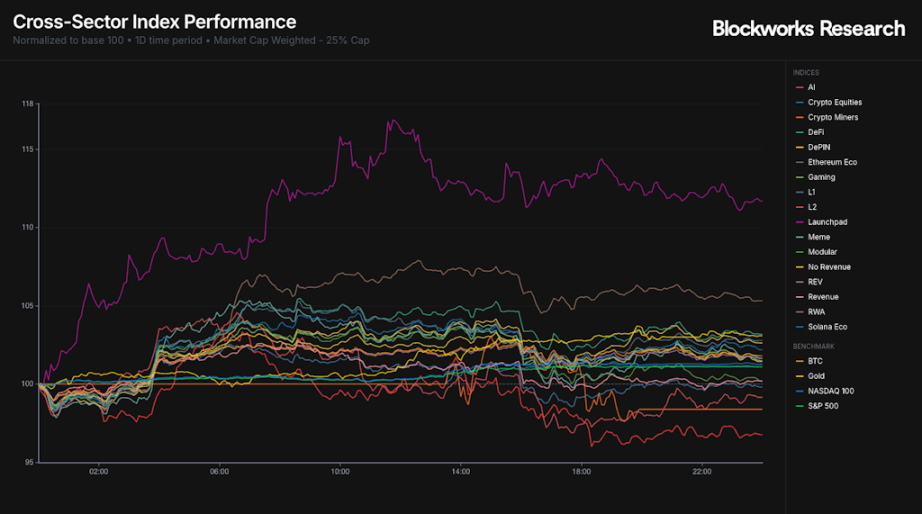
On a weekly chart, recent strength in the Launchpad sector has made it a relative winner, surpassed only by gold, which again neared its all-time high on Monday. Overall, following the historic liquidation event, most indices remained negative on a weekly basis. Among the Launchpad indices, the BSC-based Launchpad project AUCTION was the only one to show positive weekly gains, rising 46%.
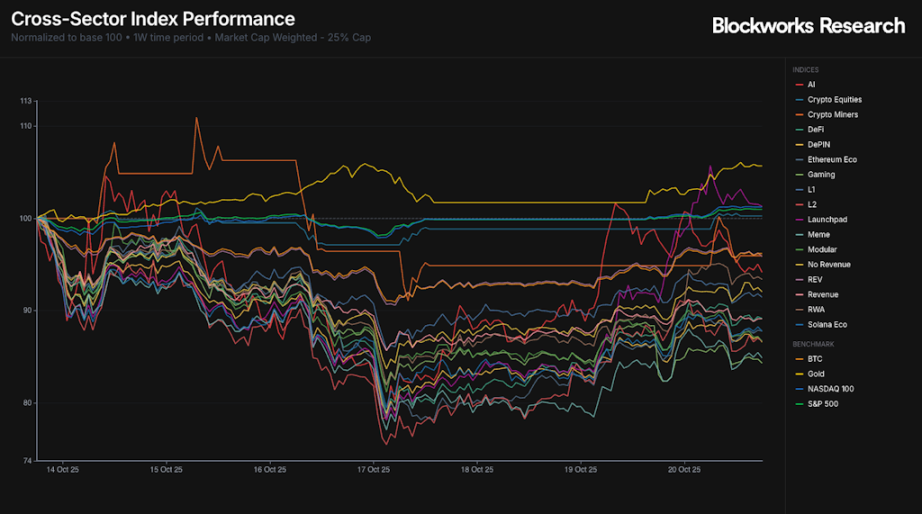
While showing some short-term gains, the monthly chart shows that nearly all cryptocurrency indices have fallen over the past 30 days. The October 10th liquidation event led to widespread weakness, with gold, cryptocurrency miners, AI, and stock indices being the only areas of strength.
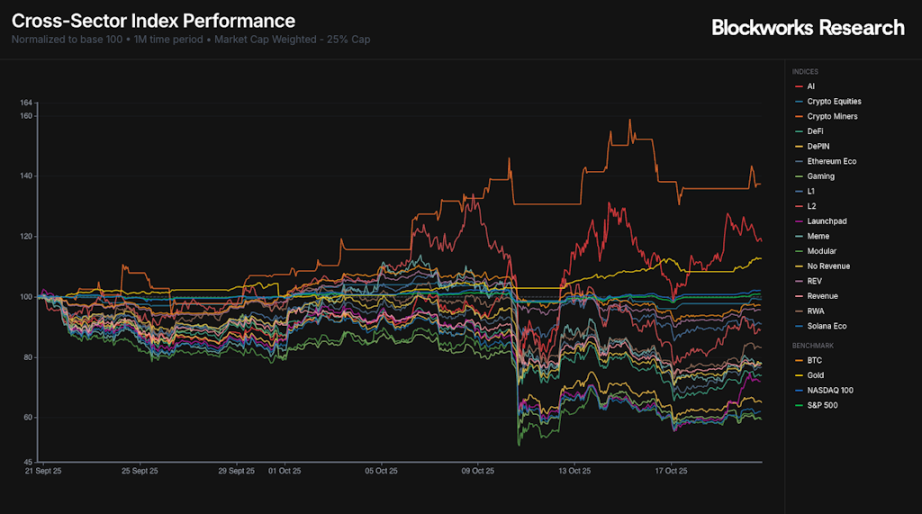
The VIX has retreated significantly, now trading at 18 after surging to 29 on Friday morning. Both the S&P 500 and Nasdaq rose during Monday's trading session, closing within striking distance of all-time highs.
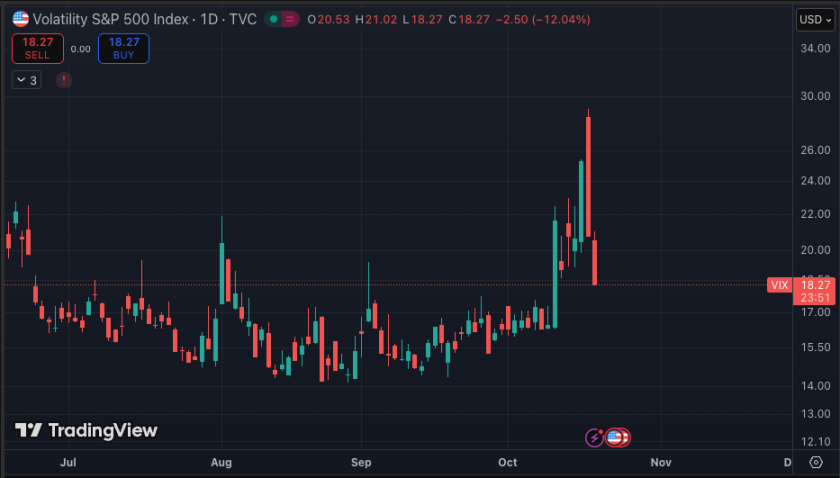
Market Update
ETF flows remain flat and negative. Monday's data showed $40 million in outflows from the BTC ETF, $145 million from the ETH ETF, and $27 million in inflows from the SOL ETF. Weekly, net ETF outflows totaled $1.5 billion last week, reversing some of the gains from a very strong start to October. The SOL ETF was the only product to show net inflows, adding $14 million.
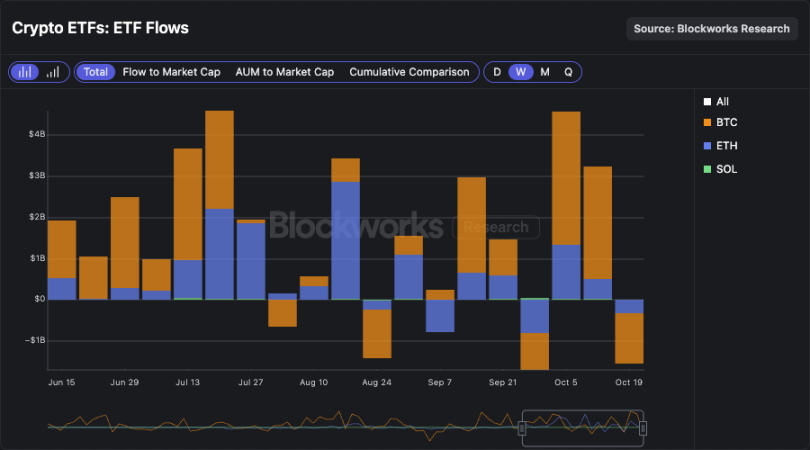
Among DATCOs, BMNR leads the pack. The entity currently holds 3,236,014 ETH, exceeding all other ETH DATCOs combined and representing 2.67% of the total ETH supply. Notably, since the end of August, BMNR has accumulated nearly 70% of its ETH holdings, while most other ETH DATCOs have maintained similar holdings. In doing so, BMNR's market share of ETH held by DATCOs has grown from 50% to nearly 65%.
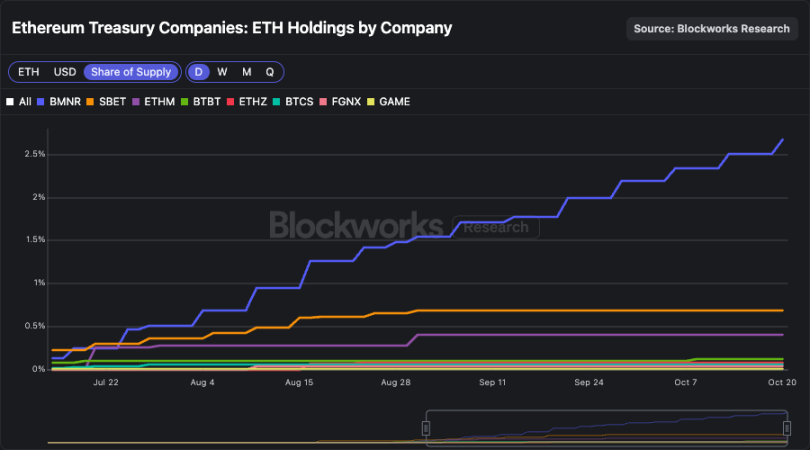
This trend is also reflected in the trading volume of ETH DATCOs. BMNR accounts for 60-85% of ETH DATCO trading volume, making its stock the most liquid. This liquidity garners the attention of larger allocators and reduces the marginal price impact of ATM issuances. BMNR appears to be the clear winner in the ETH treasury company sector.
Among SOL DATCOs, the picture is less clear. FORD remains the largest entity, with almost all of its holdings derived from proceeds of PIPE offerings. Despite authorizing a $4 billion ATM issuance program, the entity has yet to significantly increase its holdings through ATM issuances.
Holdings growth remains weak, with HSDT recently moving into second place.
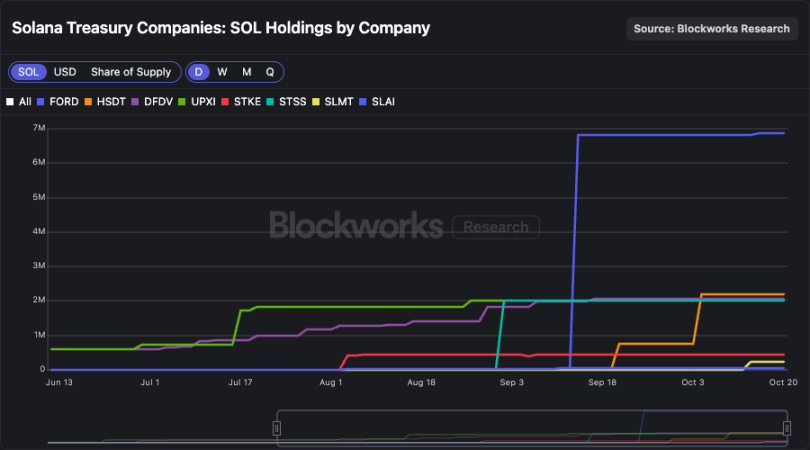
Trading volume in SOL DATCOs tells a similar story. While DFDV once dominated the sector's trading volume, the situation has shifted to a more even distribution among top names. While FORD holds approximately 43% of SOL held by DATCOs, it only accounts for approximately 10% of the sector's trading volume, indicating relatively low turnover in its shares. These data likely explain the relatively low accumulation of SOL through FORD's ATM issuance.
While BMNR is emerging as the clear winner in the ETH space, the leadership in the SOL space may still be up in the air. In the coming month, we expect trading volume to become increasingly concentrated in the top companies.
Meteora's TGE: What is the fair value of MET?
The highly anticipated Meteora TGE will take place on Thursday, October 23rd. Contrary to the recent trend of projects conducting ICOs, Meteora will not be raising funds before the TGE. Instead, it will airdrop tokens to eligible recipients, including Mercurial stakeholders, Meteora liquidity providers, JUP stakers, and Launchpad partners. Airdrop recipients will receive unlocked MET by default or can choose to provide liquidity at launch to earn trading fees.
Meteora was launched in February 2023 by the Jupiter team, Solana's largest DEX aggregator and perpetual contract trading platform. When Meteora launched, the previous iteration of the protocol, Mercurial Finance, was discontinued. The reason for shutting down Mercurial and its governance token was due to a significant amount of MER involved with FTX/Alameda, so the team decided the best course of action was to rebuild the platform with a new token.
Back in 2023, the team announced that 20% of all MET tokens would be distributed to Mercurial stakeholders at the TGE. As shown below, the team has lived up to their initial promise, with 15% allocated to Mercurial stakeholders and 5% to the Mercurial Reserve. Additionally, the DEX has been running a points program since January 31, 2024, which will allocate a total of 15% of all MET. At launch, 48% of the MET supply will be in circulation, a high percentage compared to other notable token launches in the Solana ecosystem.
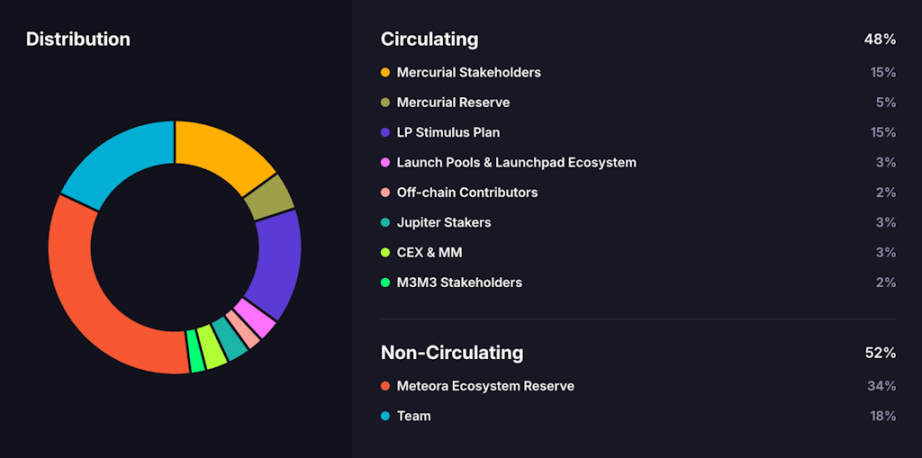
Source: https://met.meteora.ag/
As previously mentioned, 10% of the total supply will be used to bootstrap initial liquidity through a dynamic AMM pool, starting at $0.50 and distributing liquidity up to a $7.5 billion valuation. The early liquidity pool is one-sided, with early buyers exchanging their USDC for MET. Note that pool fees will start high and decrease dramatically over time through a fee scheduler.
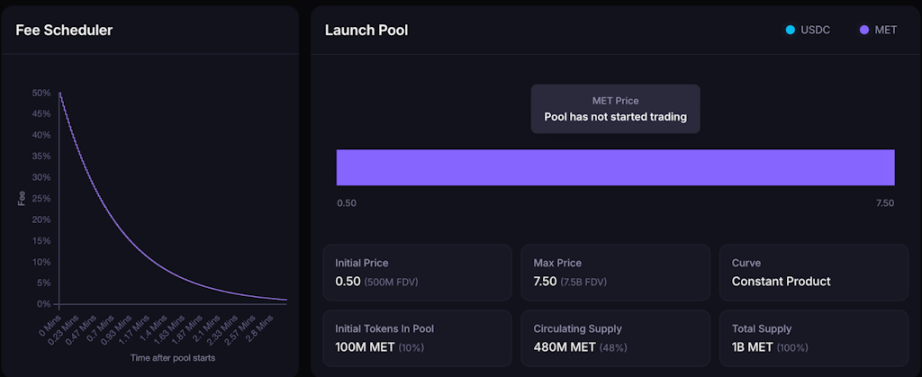
Source: https://met.meteora.ag/
Valuation calculation
DEXs, especially on Solana, lack significant moats because they lack a frontend. This dynamic is best exemplified by Raydium, which lost millions of dollars in trading volume and revenue after Pump decided to direct graduated tokens to its own AMM, PumpSwap. Meteora is attempting to mitigate this issue through vertical integration, expanding its distribution capabilities through Jupiter and selected Launchpad partners.
As mentioned previously, this DEX works closely with the Jupiter team, which has become a popular gateway for retail users to conduct on-chain transactions. Furthermore, Meteora launched a Launchpad in August 2024 in partnership with Moonshot and has since brought on new partners, including Believe, BAGS, and Jup Studio. The chart below shows that Launchpad activity has contributed between $200,000 and $800,000 in weekly revenue to Meteora in recent weeks, with the majority of traffic coming from Believe and BAGS.
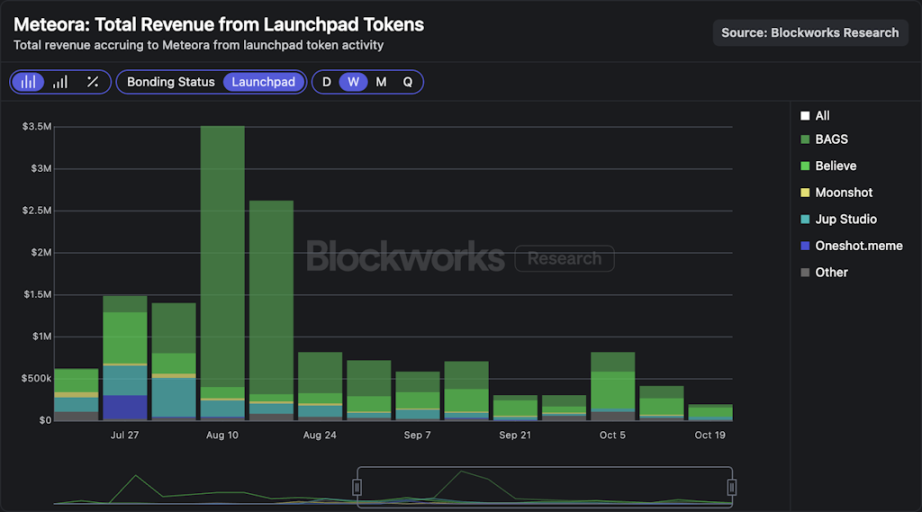
Looking at overall financial data, Meteora generated $8.8 million in revenue across all its pools over the past 30 days, consistently generating close to $1.5 million in weekly revenue even during periods of relatively low on-chain activity. Notably, over 90% of Meteora's revenue comes from Memecoin pools, which typically have higher fee tiers than SOL-stablecoin, project token, LST, and stablecoin-stablecoin pools.
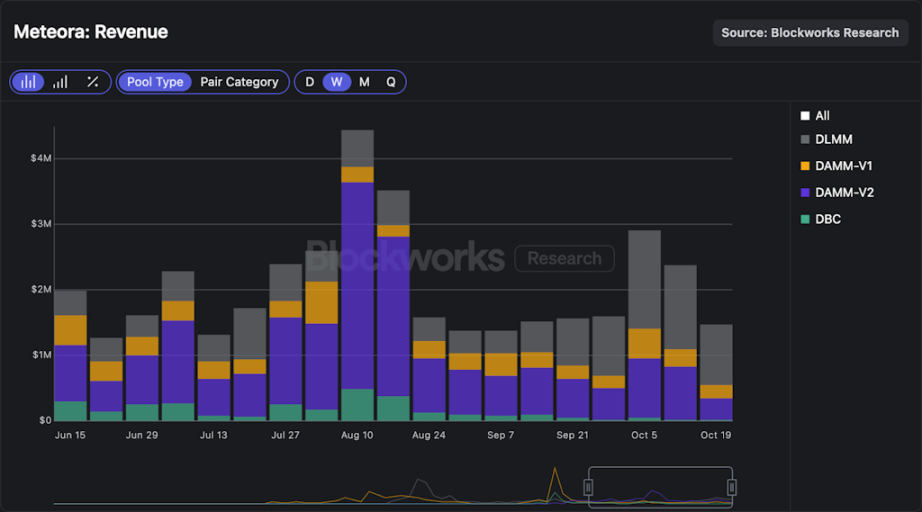
Regarding valuation, we can use Raydium and Orca as comparable companies. The chart below shows the year-to-date price-to-sales ratios of RAY and ORCA based on 30-day annualized data. We observe that the two assets were priced at relatively similar ratios until September, after which RAY began trading at a premium. For a broader perspective, the median price-to-sales ratio for both assets in 2025 is 9x.
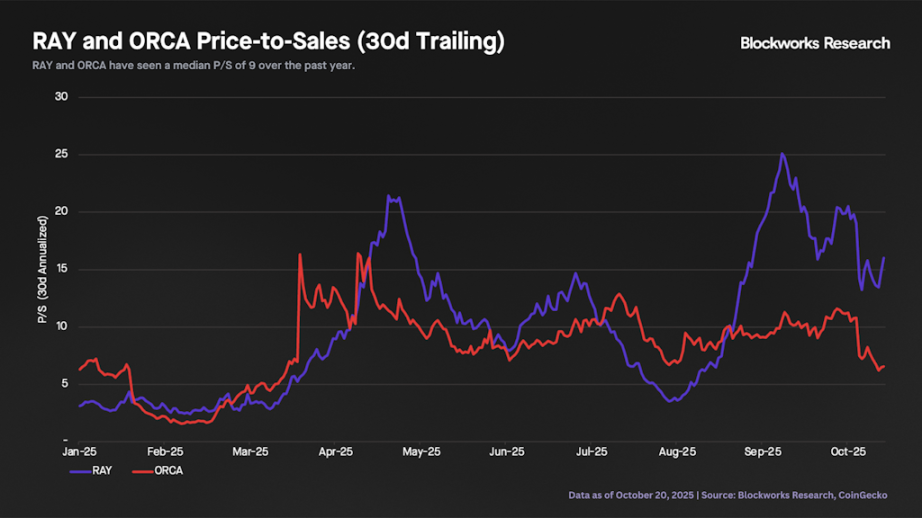
The table below compares the price-to-sales ratios of RAY and ORCA across various review periods. We observe that ORCA trades very similarly across all annualized timeframes, trading at a price-to-sales ratio of approximately 6x. In contrast, RAY has become more expensive in recent months as revenue has declined. For Meteora, we see annualized revenue ranging from approximately $75 million to approximately $115 million, depending on the review period.
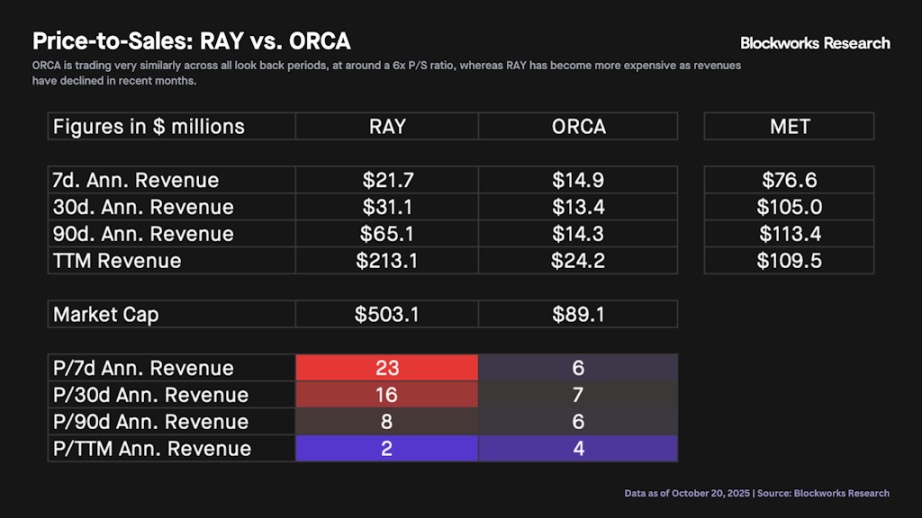
Finally, the chart below illustrates MET's potential valuations across various revenue and price-to-sales ratio ranges. Based on historical pricing patterns for RAY and ORCA, a price-to-sales ratio between 6x and 10x is most likely. Therefore, it's reasonable to expect MET to trade between $450 million and $1.1 billion after launch. Note that based on the figures below, valuations above $1 billion begin to appear expensive relative to comparable companies, while those above $2 billion almost certainly make MET overvalued unless it can improve its revenue run rate.



